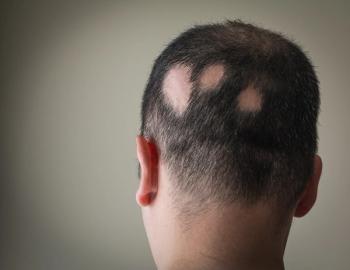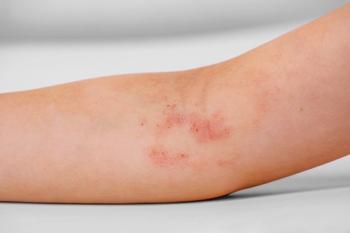
- Consultant for Pediatricians Vol 10 No 1
- Volume 10
- Issue 1
Positional Plagiocephaly, Part 2: Prevention and Treatment
Primary care pediatric providers are instrumental in educating new parents about how to prevent the development or progression of plagiocephaly.
ABSTRACT: An important part of prevention and treatment of positional plagiocephaly is head repositioning. Encourage parents to provide “tummy time” while the infant is awake and alter the supine head position during sleep. Behavioral modifications need to be implemented at a young age, ideally before age 5 to 6 months, to be effective. Infants with associated torticollis require physical therapy that consists of a series of neck exercises performed by parents at home. An orthotic cranial molding helmet can be considered for infants with moderate to severe deformity who are young enough to benefit from therapy. Beginning helmet therapy early provides the best results. Initiation or continuation of this therapy after age 1 year achieves little benefit because of the firmer cranial bone.
Primary care pediatric providers are instrumental in educating new parents about how to prevent the development or progression of plagiocephaly. The patient's age at presentation and the severity of deformity are the 2 main factors affecting treatment and, as a result, the ultimate outcome. While a universal treatment plan is lacking, there is a general consensus on the approach to the child who has deformational plagiocephaly.
In part 1 of this 2-part article (Consultant For Pediatricians, December 2010, page 421), we provided a practical guide to the evaluation of the infant with an odd-shaped skull in which we focused on how to distinguish positional plagiocephaly from craniosynostosis. Here we discuss strategies to prevent skull deformation and treatment of infants with nonsynostotic plagiocephaly.
PREVENTION STRATEGIES
The Table lists the American Academy of Pediatrics' (AAP) recommendations for how to avoid the development of positional plagiocephaly.1 An important part of prevention and treatment is head repositioning. In addition to the head repositioning techniques listed in the Table, it may also help to face the infant's crib in a direction toward auditory and visual stimulation that entices the infant to lie on the unaffected side. Parents should also be encouraged to pay attention to how they hold the infant during feedings and avoid putting pressure on the flattened part of the skull. As per the AAP's recommendations, supine positioning during unattended sleep needs to be stressed to new parents to prevent the incidence of sudden infant death syndrome. However, parents should be reminded that a significant amount of prone positioning (“tummy time”) during times of supervised wakefulness is necessary to promote shoulder girdle strength and enhance motor development. One study noted that infants with positional plagiocephaly associated with supine positioning had less than 5 minutes per day of tummy time.2 It is equally important to stress the need for supine positioning during sleep and prone positioning during wakeful periods among secondary caregivers (child care providers, grandparents, foster parents, and babysitters).
Head repositioning techniques can be introduced at birth, during the first 6 weeks of life (when infants are more likely to be sleeping in a supine position and not have their head position varied), or at the first sign of occipital flattening. To effectively prevent positional plagiocephaly, these behavioral modifications should be implemented at a young age, ideally before age 5 to 6 months.
PHYSICAL THERAPY
There is a high concordance between positional plagiocephaly and the presence of torticollis, with the latter often underreported.3 Infants with positional plagiocephaly and associated torticollis require referral to a physical therapist. Pediatric physical therapists can teach caregivers how to carry the child to lengthen the sternocleidomastoid muscle, how to encourage playing in a prone position, and how to alter eating positions to diminish the side preference.4 As part of therapy, parents are taught a series of neck exercises that they must perform at home in order for treatment to be successful. The exercises include gentle rotation of the infant's head in 3 directions:
•Chin to shoulder (lateral rotation), turning infant's head to the side.
•Ear to shoulder (lateral flexion), rotating infant's head down at an angle.
•Chin to chest (flexion), moving infant's head down without turning.
The head is held in each position for 10 seconds. These exercises should be performed bilaterally in sets of 3 to stretch the sternocleidomastoid and trapezius muscles. The entire exercise program takes about 2 minutes to complete. Some parents find it useful to perform these exercises with each diaper change.
For the infant with associated torticollis, physical therapy should be continued during the period of helmet therapy (if necessary) and discontinued when the muscles are sufficiently stretched to a symmetrical position.
HELMET THERAPY
After an assessment confirms the presence of moderate to severe deformity, effective treatment of patients with nonsynostotic positional plagiocephaly is use of an orthotic cranial molding helmet (Figure). Indications for the use of helmet therapy are debatable. We use helmet therapy primarily in infants with moderate to severe deformity who are young enough to benefit from therapy.
Figure – This 8-month-old infant has on a typical orthotic cranial molding helmet used for treatment of positional plagiocephaly.
Clinicians may be hesitant to deny use of a helmet to infants who do not have as severe a plagiocephalic skull to warrant therapy, but whose parents are significantly concerned about the deformity. In this case, the goal is to assure parents that everything is being done for their child; this can often be achieved without offering helmet therapy.
Custom-fitted helmets are constructed from a plaster mold or CT scan of the infant's head and assist with skull reshaping. They consist of an outer layer of polyethylene copolymer with an inner polyethylene foam layer. They are fashioned to be tight to allow growth where the head is flat and restrict growth where the head is prominent.
Timing and duration. Helmet therapy can begin as soon as the child presents to a craniofacial surgeon and is deemed an appropriate candidate. Therapy that is initiated early capitalizes on the still malleable cranial bone and provides the best results. Remodeling is less successful when started close to or after age 12 months. A dedicated and compliant caregiver is imperative for success of therapy, because infants may not embrace the helmet eagerly at first. After a short period of acclimation, the helmet should be worn for 23 hours a day. Regular follow-up with the surgeon and orthotist to assess the progress of remodeling is necessary. Infants often require a mean of 4 to 6 months of helmet therapy. However, continuing therapy after 1 year of age achieves little benefit because of the firmer cranial bone.
Drawbacks. Helmet therapy has several disadvantages. It requires multiple visits to the orthotist to reline the inner foam as the head shape changes and to the surgeon to evaluate the progress and confirm that there are no areas of pressure injury to the skin. During the summer months, the helmet's interior may become hot and malodorous, which may be bothersome to the child as well as the family. Another possible deterrent is cost. Not all insurance providers cover use of a molding helmet, and the out-of-pocket costs can be high. Finally, the social stigma attached to the helmet-the incorrect assumption from onlookers that the child wearing the helmet has a problem with mental development-may deter parents from proceeding with the therapy.
SURGERY
Plagiocephaly. Surgery may be required in rare cases of severe, persistent nonsynostotic plagiocephaly. In these cases, the sutures are open but the overall head shape is grossly deformed and would probably affect the child's social development. Most often, surgery is recommended for suture fusion (craniosynostosis).5,6
Craniosynostosis. In most instances, molding helmet therapy cannot correct the deformity of craniosynostosis. It is recommended that children with documented or suspected craniosynostosis be referred to a pediatric craniofacial surgeon for evaluation and management. Significant deformity caused by fusion of the sagittal suture, one or both coronal sutures, metopic suture, and/or one or both lambdoid sutures is treated with suture removal and calvarial vault reconstruction. This may be done via either an open or endoscopic approach. The endoscopic approach is usually performed earlier in the first year of life, whereas the open approach is recommended at around 8 to 12 months of age.
In general, the endoscopic approach offers the advantages of less operative time and less blood loss as well as more rapid discharge from the hospital. However, it often does not correct the deformity at the time of operation but relies on adequate postoperative helmet therapy to effect more noticeable change. Although it is more invasive, the open approach allows immediate and precise alteration in the head shape. Some milder cases of synostosis, in which only a portion of the suture is involved and the visual facial deformity is mild or nonexistent, may be observed for evidence of increased intracranial pressure without operative intervention.
References:
REFERENCES:
1. American Academy of Pediatrics Task Force on Sudden Infant Death Syndrome. The changing concept of sudden infant death syndrome: diagnostic coding shifts, controversies regarding the sleeping environment, and new variables to consider in reducing risk. Pediatrics. 2005;116:1245-1255.
2. Hutchison BL, Thompson JM, Mitchell EA. Determinants of nonsynostotic plagiocephaly: a case-control study. Pediatrics. 2003;112:e316.
3. Rogers GF, Oh AK, Mulliken JB. The role of congenital muscular torticollis in the development of deformational plagiocephaly. Plast Reconstr Surg. 2009;123:643-652.
4. Biggs WS. Diagnosis and management of positional head deformity. Am Fam Physician. 2003;67: 1953-1956.
5. Persing J, James H, Swanson J, Kattwinkel J; American Academy of Pediatrics Committee on Practice and Ambulatory Medicine, Section on Plastic Surgery and Section on Neurological Surgery. Prevention and management of positional skull deformities in infants. Pediatrics. 2003;112 (1 pt 1):199-202.
6. Pollack IF, Losken HW, Fasick P. Diagnosis and management of posterior plagiocephaly. Pediatrics. 1997;99:180-185.
Articles in this issue
almost 15 years ago
Flank Pain, Decreased Urine Output in Young Boyalmost 15 years ago
What Rash Consists of These Brownish Macules?almost 15 years ago
Pityriasis Rosea in Dark-Skinned Childrenalmost 15 years ago
Hydrocephalus Secondary to GBS Meningitisalmost 15 years ago
Observation and Documentation Still the Foundation of Medical Practicealmost 15 years ago
Assigning Blame in Medicine: Where Are We Headed?almost 15 years ago
X-Linked Ichthyosisalmost 15 years ago
MRSA Abscess Attributed to Spider Bitealmost 15 years ago
Systemic Lupus Erythematosusalmost 15 years ago
Toddler With Chest Pain, Trouble Breathing, Cough After Heart SurgeryNewsletter
Access practical, evidence-based guidance to support better care for our youngest patients. Join our email list for the latest clinical updates.














